Using Deep Learning in a Monocentric Study to Characterize Maternal Immune Environment for Predicting Pregnancy Outcomes in the Recurrent Reproductive Failure Patients
- PMID: 33868275
- PMCID: PMC8047052
- DOI: 10.3389/fimmu.2021.642167
Using Deep Learning in a Monocentric Study to Characterize Maternal Immune Environment for Predicting Pregnancy Outcomes in the Recurrent Reproductive Failure Patients
Abstract
Recurrent reproductive failure (RRF), such as recurrent pregnancy loss and repeated implantation failure, is characterized by complex etiologies and particularly associated with diverse maternal factors. It is currently believed that RRF is closely associated with the maternal environment, which is, in turn, affected by complex immune factors. Without the use of automated tools, it is often difficult to assess the interaction and synergistic effects of the various immune factors on the pregnancy outcome. As a result, the application of Artificial Intelligence (A.I.) has been explored in the field of assisted reproductive technology (ART). In this study, we reviewed studies on the use of A.I. to develop prediction models for pregnancy outcomes of patients who underwent ART treatment. A limited amount of models based on genetic markers or common indices have been established for prediction of pregnancy outcome of patients with RRF. In this study, we applied A.I. to analyze the medical information of patients with RRF, including immune indicators. The entire clinical samples set (561 samples) was divided into two sets: 90% of the set was used for training and 10% for testing. Different data panels were established to predict pregnancy outcomes at four different gestational nodes, including biochemical pregnancy, clinical pregnancy, ongoing pregnancy, and live birth, respectively. The prediction models of pregnancy outcomes were established using sparse coding, based on six data panels: basic patient characteristics, hormone levels, autoantibodies, peripheral immunology, endometrial immunology, and embryo parameters. The six data panels covered 64 variables. In terms of biochemical pregnancy prediction, the area under curve (AUC) using the endometrial immunology panel was the largest (AUC = 0.766, accuracy: 73.0%). The AUC using the autoantibodies panel was the largest in predicting clinical pregnancy (AUC = 0.688, accuracy: 78.4%), ongoing pregnancy (AUC = 0.802, accuracy: 75.0%), and live birth (AUC = 0.909, accuracy: 89.7%). Combining the data panels did not significantly enhance the effect on prediction of all the four pregnancy outcomes. These results give us a new insight on reproductive immunology and establish the basis for assisting clinicians to plan more precise and personalized diagnosis and treatment for patients with RRF.
Keywords: artificial intelligence; assisted reproductive technology; recurrent reproductive failure; reproductive immunology; sparse coding.
Copyright © 2021 Huang, Xiang, Zhang, Tan, Yip, Liu, Li, Yu, Diao, Wong, Ling, Zeng and Tu.
Conflict of interest statement
DT, CY, LW, and WL were employed by the company ALOM Intelligence Limited, Hong Kong, China. The remaining authors declare that the research was conducted in the absence of any commercial or financial relationships that could be construed as a potential conflict of interest.
Figures
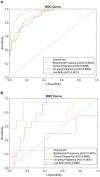
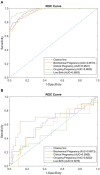
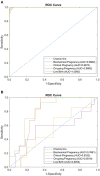
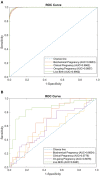
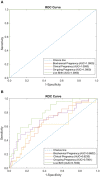
Similar articles
-
Immunological parameters of maternal peripheral blood as predictors of future pregnancy outcomes in patients with unexplained recurrent pregnancy loss.Acta Obstet Gynecol Scand. 2024 Jul;103(7):1444-1456. doi: 10.1111/aogs.14832. Epub 2024 Mar 21. Acta Obstet Gynecol Scand. 2024. PMID: 38511530 Free PMC article.
-
Identifying biomarkers for predicting successful embryo implantation: applying single to multi-OMICs to improve reproductive outcomes.Hum Reprod Update. 2020 Feb 28;26(2):264-301. doi: 10.1093/humupd/dmz042. Hum Reprod Update. 2020. PMID: 32096829 Review.
-
Evaluation of peripheral and uterine immune status of chronic endometritis in patients with recurrent reproductive failure.Fertil Steril. 2020 Jan;113(1):187-196.e1. doi: 10.1016/j.fertnstert.2019.09.001. Epub 2019 Nov 9. Fertil Steril. 2020. PMID: 31718829
-
Pregnancy outcomes after assisted human reproduction.J Obstet Gynaecol Can. 2014 Jan;36(1):64-83. doi: 10.1016/S1701-2163(15)30685-X. J Obstet Gynaecol Can. 2014. PMID: 24444289
-
Temperature of embryo culture for assisted reproduction.Cochrane Database Syst Rev. 2019 Sep 17;9(9):CD012192. doi: 10.1002/14651858.CD012192.pub2. Cochrane Database Syst Rev. 2019. PMID: 31529804 Free PMC article.
Cited by
-
Translational Bioinformatics for Human Reproductive Biology Research: Examples, Opportunities and Challenges for a Future Reproductive Medicine.Int J Mol Sci. 2022 Dec 20;24(1):4. doi: 10.3390/ijms24010004. Int J Mol Sci. 2022. PMID: 36613446 Free PMC article. Review.
-
Artificial intelligence in Immuno-genetics.Bioinformation. 2024 Jan 31;20(1):29-35. doi: 10.6026/973206300200029. eCollection 2024. Bioinformation. 2024. PMID: 38352901 Free PMC article. Review.
-
Performance Evaluation of Machine Learning Algorithm for Classification of Unintended Pregnancy among Married Women in Bangladesh.J Healthc Eng. 2022 May 28;2022:1460908. doi: 10.1155/2022/1460908. eCollection 2022. J Healthc Eng. 2022. PMID: 35669979 Free PMC article.
-
Immunological parameters of maternal peripheral blood as predictors of future pregnancy outcomes in patients with unexplained recurrent pregnancy loss.Acta Obstet Gynecol Scand. 2024 Jul;103(7):1444-1456. doi: 10.1111/aogs.14832. Epub 2024 Mar 21. Acta Obstet Gynecol Scand. 2024. PMID: 38511530 Free PMC article.
-
Risk prediction model based on machine learning for predicting miscarriage among pregnant patients with immune abnormalities.Front Pharmacol. 2024 Apr 22;15:1366529. doi: 10.3389/fphar.2024.1366529. eCollection 2024. Front Pharmacol. 2024. PMID: 38711993 Free PMC article.
References
Publication types
MeSH terms
Substances
LinkOut - more resources
Full Text Sources
Other Literature Sources
Medical
Research Materials

